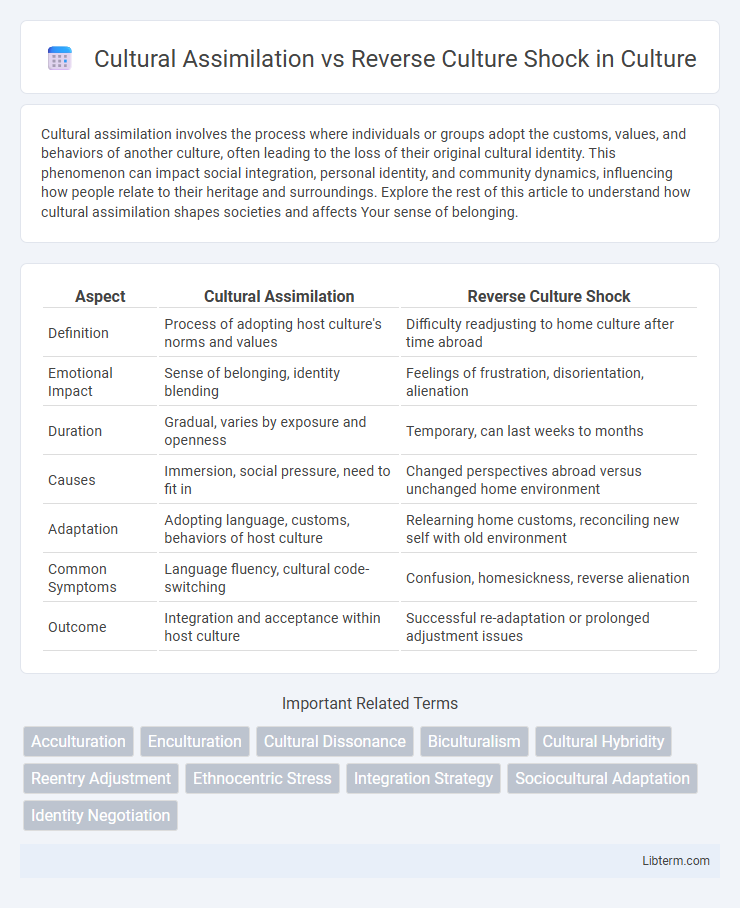Cultural assimilation involves the process where individuals or groups adopt the customs, values, and behaviors of another culture, often leading to the loss of their original cultural identity. This phenomenon can impact social integration, personal identity, and community dynamics, influencing how people relate to their heritage and surroundings. Explore the rest of this article to understand how cultural assimilation shapes societies and affects Your sense of belonging.
Table of Comparison
| Aspect | Cultural Assimilation | Reverse Culture Shock |
|---|---|---|
| Definition | Process of adopting host culture's norms and values | Difficulty readjusting to home culture after time abroad |
| Emotional Impact | Sense of belonging, identity blending | Feelings of frustration, disorientation, alienation |
| Duration | Gradual, varies by exposure and openness | Temporary, can last weeks to months |
| Causes | Immersion, social pressure, need to fit in | Changed perspectives abroad versus unchanged home environment |
| Adaptation | Adopting language, customs, behaviors of host culture | Relearning home customs, reconciling new self with old environment |
| Common Symptoms | Language fluency, cultural code-switching | Confusion, homesickness, reverse alienation |
| Outcome | Integration and acceptance within host culture | Successful re-adaptation or prolonged adjustment issues |
Understanding Cultural Assimilation
Cultural assimilation involves individuals adopting the cultural norms and values of a dominant or host society, often leading to significant changes in language, behavior, and identity. Understanding cultural assimilation requires recognizing the psychological and social adjustments individuals make to fit into new cultural environments while balancing the preservation of their original cultural identity. This process can facilitate social integration but also poses challenges related to identity conflict and loss of cultural heritage.
Defining Reverse Culture Shock
Reverse culture shock occurs when individuals experience difficulty readjusting to their home culture after an extended period abroad. Unlike cultural assimilation, which involves adapting to a new culture, reverse culture shock challenges one's expectations and comfort with familiar environments due to changes in personal perspectives. Symptoms often include feelings of disorientation, frustration, and isolation as returning individuals struggle to reintegrate into their native social norms.
Key Differences Between Assimilation and Reverse Culture Shock
Cultural assimilation involves the process where individuals adopt the customs, values, and behaviors of a new culture, often leading to a gradual loss of their original cultural identity. Reverse culture shock occurs when individuals return to their home culture and experience disorientation, frustration, or alienation due to changes in themselves or their environment. Key differences include assimilation being an adaptive process to a foreign culture, while reverse culture shock reflects challenges in readjusting to a familiar environment after prolonged absence.
Psychological Impacts of Cultural Assimilation
Cultural assimilation often leads to significant psychological impacts such as identity confusion, stress, and emotional distress due to the pressure to conform to the dominant culture while suppressing one's original cultural traits. Individuals may experience a loss of self-esteem and feelings of alienation as they navigate the challenges of integrating new cultural norms with their pre-existing values. This psychological struggle can result in anxiety, depression, and a persistent sense of disconnection from both their heritage culture and the host culture.
Common Triggers of Reverse Culture Shock
Common triggers of reverse culture shock include changes in social norms, differences in communication styles, and altered expectations upon re-entry to the home culture. Individuals often experience frustration with family dynamics, workplace adjustments, and a sense of disconnection from familiar cultural references. These challenges highlight the psychological and emotional impact of transitioning back after significant cultural assimilation abroad.
Coping Strategies for Cultural Assimilation
Effective coping strategies for cultural assimilation include active engagement in local customs, language acquisition, and forming social connections within the host community to foster a sense of belonging. Developing cultural self-awareness and maintaining a flexible mindset help individuals navigate cultural differences while reducing stress. Utilizing support networks such as expatriate groups or cultural mentors enhances adaptation and accelerates the assimilation process.
Managing Reverse Culture Shock: Practical Tips
Managing reverse culture shock requires developing realistic expectations about the home environment, maintaining open communication with friends and family, and seeking support groups or counseling if needed. Reintegrating into familiar settings benefits from gradually re-engaging with cultural norms while embracing the changes experienced abroad. Practicing self-care and reflecting on the growth gained during immersion abroad can ease the transition and promote emotional resilience.
Case Studies: Experiences of Culture Transition
Case studies on cultural assimilation reveal individuals navigating identity shifts and social integration challenges when adapting to new cultural environments. Reverse culture shock studies focus on the psychological and emotional difficulties experienced upon returning to one's home culture, highlighting feelings of alienation and re-entry stress. Comparative analyses indicate that both processes significantly impact mental health and require tailored support strategies for effective cultural transition.
Long-term Effects on Identity and Belonging
Cultural assimilation often leads to a complex redefinition of identity as individuals gradually adopt new social norms and values, sometimes resulting in a diminished connection to their original culture. Reverse culture shock can cause long-term identity confusion, as returning individuals struggle to reconcile their transformed perspectives with their home environment's unchanged cultural expectations. Both phenomena profoundly impact one's sense of belonging, challenging stability in cultural affiliation and social integration over extended periods.
Building Resilience During Cross-Cultural Transitions
Building resilience during cross-cultural transitions involves navigating cultural assimilation and reverse culture shock by developing adaptive coping strategies and emotional flexibility. Emphasizing cultural awareness and open communication fosters smoother integration into new environments while preparing individuals to readjust upon returning home. Strengthening resilience through mindfulness and social support networks mitigates stress and enhances overall psychological well-being during these complex cultural adjustments.
Cultural Assimilation Infographic

 libterm.com
libterm.com